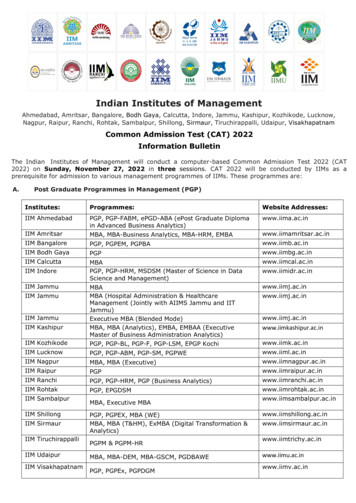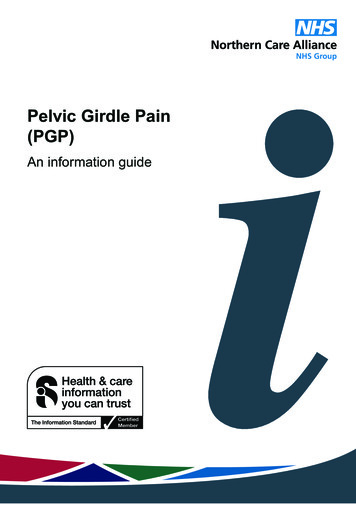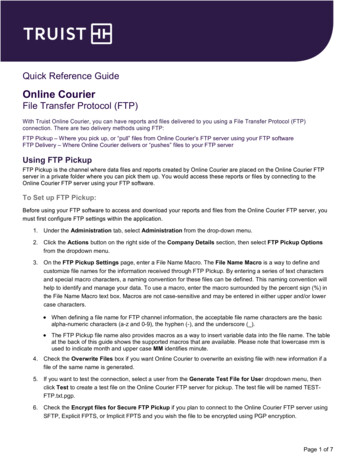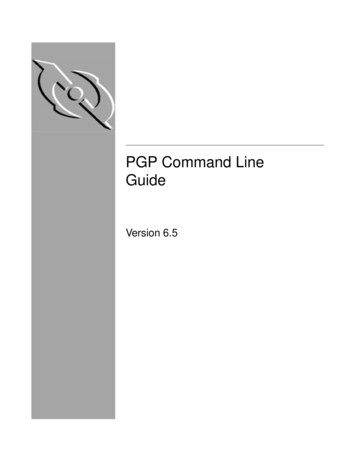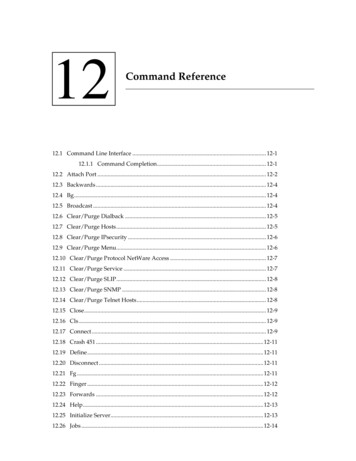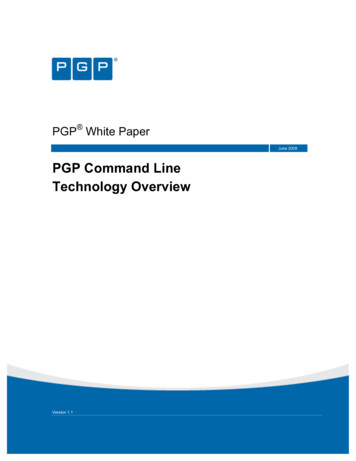
Transcription
PGP White PaperJune 2008PGP Command LineTechnology OverviewVersion 1.1
PGP White Paper – PGP Command Line Technology Overview2Table of ContentsTABLE OF CONTENTS.2EXECUTIVE SUMMARY .3CHOOSING THE RIGHT SOLUTION .4DATA: ALWAYS IN TRANSIT . 4Session Encryption . 4File Encryption . 4A STANDARD SOLUTION A PPROACH . 5PGP Command Line. 5REAL-LIFE USE CASES . 7ACS . 7Bertelsmann . 7DeKalb Medical Center . 7PHNS. 7Rule Financial . 8Texas State Bank . 8SECURING AUTOMATED BUSINESS PROCESSES .8GLOBALCPG CORPORATION . 8DAILY TRANSMISSION TO EXTERNAL TRADING P ARTNERS . 9PGP Command Line Integration . 9Scripting . 10INTERNAL NETWORK TRANSFER OF DAILY FINANCIAL RESULTS . 10PGP Command Line Integration . 11Scripting . 11TAPE B ACKUP TRANSPORT TO OFFSITE STORAGE . 12PGP Command Line Integration . 12Scripting . 13DATA DISTRIBUTION TO PARTNERS WITHOUT ENCRYPTION SOFTWARE . 15PGP Command Line Integration . 15Scripting . 16CONCLUSION .17Additional Resources. 17 2008 PGP Corporation. All Rights Reserved.APPROVED FOR EXTERNAL DISTRIBUTIONCLTOWP080620
PGP White Paper – PGP Command Line Technology Overview3Executive SummaryData transfer and processing systems form the circulatory system of most organizations, exchanginglarge volumes of information between internal systems, suppliers, and customers. But legacy datatransfer and processing systems are especially prone to security breaches because traditional filetransfer and email protocols have no built-in security. For organizations that must securely exchange large volumes of information, PGP Command Linecan protect business-critical data easily and with little impact on existing systems. PGP CommandLine can also be used to protect large volumes of information stored on servers and backup mediafrom unauthorized access.This Technology Overview presents examples of ways that PGP Command Line can be used toencrypt data in automated business processes. The white paper is intended for IT managers andtechnical implementers who are responsible for developing, managing, and securing businessprocesses. Sample scripts show how easily organizations can integrate PGP Command Line. If youhave more complex requirements, PGP Corporation and its partners can help you plan thetechnology upgrade and guide you through the process. 2008 PGP Corporation. All Rights Reserved.APPROVED FOR EXTERNAL DISTRIBUTIONCLTOWP080620
PGP White Paper – PGP Command Line Technology Overview4Choosing the Right SolutionAutomated business processes that store and forward critical information are becoming more andmore risky. Malicious code, hacks, and internal compromises can quickly turn a corporate asset intoa liability.Whether mishandled, lost, stolen, or intercepted, data can become your worst enemy. Lost backuptapes, stolen computers, and misused privileges all represent common data security breaches. Therise in identity theft has turned these breaches from purely internal matters into incidents withsignificant financial and legal ramifications. Breaches are often widely publicized, hurting theorganization’s reputation; the TJX credit card breach that affected over 100 million accounts is just12one example. And the average cost of a compromised record is 197, according to a 2007 study .In other words, a privacy breach will reduce your organization’s profits, may cost you your job, andcould even mean the end of your organization itself.The risk of security breaches has led many organizations to reconsider how they handle data intransit and at rest.Data: Always In TransitData is often described as in transit or at rest; however, this categorization is less than perfect. Datais almost always in transit, whether transferred via FTP over the Internet, stored in a storage areanetwork (SAN), or archived on a backup tape in a delivery truck en route to offsite storage. Datacommonly referred to as “at rest” is often actually waiting to be transferred.Different means of encryption have commonly been used to protect data in transit and data at rest.These methods include session and file encryption.Session EncryptionTo protect data being transferred over networks, temporary encryption keys used only for thesession are generated and used to encrypt a transfer from the origin to the destination. Commonsession encryption technologies include IPSec or SSL VPN connections, SSH or SFTP networktransfers, and HTTPS Web-based transfers. Although the data is protected in transit with thesemethods, it remains unencrypted before and after transfer, presenting a potential target for a breach.Another risk of session encryption is that temporary files and backups may still be found on a diskdrive, even if deleted.File EncryptionThe alternative to session encryption is to encrypt the data at rest instead of in its transit session. Inother words: encrypt the files, not the transmission, to better protect it from compromise in the eventof accidental loss or theft. Common strategies include file encryption (or archive encryption) that1A Chronology of Data Breaches, Privacy Rights nDataBreaches.htm22007 Annual Study: U.S. Cost of a Data Breach, November 2007, The Ponemon Institute,http://www.pgp.com/downloads/research reports/ponemon reg direct.html 2008 PGP Corporation. All Rights Reserved.APPROVED FOR EXTERNAL DISTRIBUTIONCLTOWP080620
PGP White Paper – PGP Command Line Technology Overview5uses OpenPGP, PKCS#7, or proprietary password encryption. File encryption secures data both atrest and n transit , which safeguards the information against a breach of the servers and interceptionover the wire.A Standard Solution ApproachWe have shown that file encryption is superior to session encryption because it protects the data inmore circumstances. This is why the security market offers a multitude of file encryption solutions.To choose the file encryption solution that is best for your organization, evaluate the variousofferings on how well they fulfill these four major requirements: Support standards-based encryption and file formats – Proprietary formats hinder the broadacceptance of encryption. Having a standards-based solution ensures that you can securelyexchange information with present and future partners, and that you can still access archiveddata for many years to come. Easily integrate with existing processes – Your organization may use a variety ofapplications to manage and process sensitive information. Choose an encryption solution that isflexible enough to integrate with both new and legacy applications. Support a broad set of platforms – Your organization may use a variety of digital platformsthat process sensitive information. Choose an encryption tool that supports a heterogeneous setof platforms and operating systems, especially if the applications that you use run on systemsas diverse as Windows servers, UNIX workstations, and midrange or mainframe systems. Youshould also consider which platforms you may need to support in the next five years. Provide advanced key management – To protect private keys and preserve access toencrypted data, the encryption solution must include advanced key management technologiessuch as central key storage and key splitting. Central key storage lets you avoid having to toucheach system when keys change or additional servers join the system; storing keys centrally isespecially important if your encryption solution connects several systems. Key splitting controlsthe access to and use of private keys for operational security. It is often used to protect criticalnon-personal keys for corporate access, such as archiving, e-discovery, or data recovery. Withkey splitting, a number of authorized key holders each receive a key share. A minimum numberof key shares, also called a “threshold,” must be met to reconstitute a key and make it availablefor use. Other advanced key management technologies that you may require in your solutioninclude methods for ensuring corporate access to encrypted data if required by policy orregulatory mandates, even in the event that a private key is lost.PGP Command LinePGP Command Line is a file encryption solution that fulfills all four of the requirements and isdesigned for flexibility. It is ideal for use with batch processing, network transfer, and backupapplications.Standards-based encryption and file formats. PGP Command Line uses standards-basedOpenPGP (IETF RFC 2440) cryptography to compress, encrypt, and digitally sign files anddirectories. The software also encrypts emails in OpenPGP and S/MIME format. Built on the PGP Software Development Kit (PGP SDK), PGP Command Line uses the same core 2008 PGP Corporation. All Rights Reserved.APPROVED FOR EXTERNAL DISTRIBUTIONCLTOWP080620
PGP White Paper – PGP Command Line Technology Overview6cryptographic libraries that are built into other PGP products. PGP Command Line also supportscommonly used file compression methods: Zip, BZip2, and ZLib.Data encrypted with PGP Command Line can be decrypted by using other PGP Command Line clients or PGP Desktop software. For users without PGP Command Line or PGP Desktop software,PGP Command Line can generate Self-Decrypting Archives (SDAs). SDAs are archives encryptedwith a passphrase that can be opened by users without PGP software. Because SDAs usesymmetric encryption, the encryption passphrase must be communicated to the intended recipient“out of band”, for example by phone, fax, or short message service (SMS). With PGP CommandLine, SDAs can be created for execution on any supported platform, allowing encrypted files to beeasily transferred for use on both desktop and server platforms (for example, by creating an SDA onSun Solaris to be decrypted on Windows XP).Easy applications integration. PGP Command Line runs as a shell-based executable. PGPCommand Line is accessible from a variety of scripting languages, including UNIX scripts, Windowsbatch scripts, PERL, and other scripting tools and applications that can call an executable and passarguments. This functionality allows PGP Command Line to be easily integrated into a wide varietyof applications, such as enterprise backup applications.Broad platform support. PGP Command Line is available on a broad range of enterprise serverplatforms. In addition to these platforms, any version of PGP Command Line can be used to createSDAs that run on another supported platform (for example, an SDA created on AIX runs anddecrypts on Windows 2003). PGP Command Line 9.8 is currently available for the following3operating systems: Windows Vista (all 32-bit and 64-bit editions) Windows 2003 (SP2) Windows XP (SP2, 32-bit and 64-bit editions) Windows 2000 (SP4) HP-UX 11i or above (PA-RISC and Itanium) IBM AIX 5.2 and 5.3 Red Hat Enterprise Linux 3.0 or above (x86 and x86 64) Sun Solaris 9 (SPARC only) and 10 (SPARC, x86, and x86 64) Fedora Core 6 and above (x86 64 only) Apple Mac OS X 10.4 and 10.5 (Universal Binary) IBM System iSeries IBM System zSeries453Please visit www.pgp.com/products/commandline for updates on supported operating systems.4Support for IBM System i available soon. Please check the PGP website.5Support for IBM System z available soon. Please check the PGP website. 2008 PGP Corporation. All Rights Reserved.APPROVED FOR EXTERNAL DISTRIBUTIONCLTOWP080620
PGP White Paper – PGP Command Line Technology Overview7Advanced key management. PGP Command Line enhances private key security by supporting keysplitting. Additionally, PGP Command Line ensures long-term accessibility to encrypted data withAdditional Decryption Key (ADK) technology. PGP Command Line can associate ADKs with PGPkeys at the time of original key generation. When information is encrypted to a PGP key with anassigned ADK, PGP Command Line will also encrypt information to the ADK. In the event that aprivate key is lost or access to encrypted data is required by policy or regulations, an ADK canregain access to and decrypt information.Real-life use casesThe following concise examples show how some customers in the financial, health care, andservices industries use PGP Command Line. Many of these customers use PGP Command Line asan integrated part of the PGP Encryption Platform and use a range of PGP solutions.ACSCustomer confidence and regulatory compliance are essential to the success of Affiliated ComputerServices, Inc. (ACS). A Fortune 500 business process and information technology outsourcer, ACShandles high volumes of sensitive corporate and customer data for clients in more than 100countries. To provide additional security, ACS purchased licenses of PGP Command Line for 150servers to secure communication between systems.BertelsmannA global media company with 97,000 employees in 60 countries, Bertelsmann needed a scalable,cost-effective encryption solution to protect sensitive data and comply with national and regionaldata privacy laws. As the foundation of its enterprise data protection strategy, Bertelsmann chosethe PGP Encryption Platform to deliver encryption across the enterprise. The Bertelsmannsubsidiary Bookspan, a U.S. book club, uses PGP Command Line to protect its file transfers withpartners.DeKalb Medical CenterDeKalb Medical Center must comply with federal regulations designed to protect the privacy ofpatient records. As part of its enterprise data protection strategy, DeKalb Medical Center chose thePGP Encryption Platform to meet all its encryption needs. DeKalb Medical Center decided to phaseout its VPN solution for its FTP server transmissions with partners and replace it with PGPCommand Line encryption.PHNSA business process outsourcer for health care providers, PHNS needed an enterprise dataprotection strategy to help comply with industry and government regulations protecting patientprivacy and financial records. PHNS chose the PGP Encryption Platform approach to deploy andmanage multiple encryption applications cost-effectively with centralized policy and keymanagement. PGP Command Line protects confidential server-to-server communications in backend patient record and financial management applications. 2008 PGP Corporation. All Rights Reserved.APPROVED FOR EXTERNAL DISTRIBUTIONCLTOWP080620
PGP White Paper – PGP Command Line Technology Overview8Rule FinancialWith customers throughout the United Kingdom and Europe, Rule Financial needs to protectsensitive data and comply with relevant industry regulations. The financial services company selected PGP Command Line to secure transactions between banks and brokers. PGP encryptionnow forms the core of Rule Financial’s enterprise data protection strategy to defend customer andbusiness partner data — wherever it goes.Texas State BankTo comply with data privacy regulations and improve its business processes, Texas State Bankchose the PGP Encryption Platform as the foundation of its enterprise data protection strategy. PGPCommand Line protects server-to-server transactions among Texas State Bank, its IT outsourcingsubsidiary, and its parent organization, BBVA.Securing Automated Business ProcessesBecause PGP Command Line is a scripting and shell-based encryption application, it can integratequickly with both off-the-shelf applications and custom scripts. PGP Command Line also providesthe advanced key management options that enterprises require for critical automated businessprocess applications, such as securing multisite FTP transfers and encrypting backup tapes foroffsite storage.To illustrate how PGP Command Line meets multiple transfer, storage, and backup encryptionrequirements, the following scenario presents an example of a mid-sized business with a variety ofencryption requirements. This hypothetical example of “GlobalCPG Corporation” includes theexperiences of real-life PGP customers, without revealing any customer’s confidential encryptionstrategies, policies, or procedures.GlobalCPG CorporationGlobalCPG Corporation is a midsized electronic consumer goods manufacturing company with 7506employees. As a subsidiary of a publicly traded conglomerate, GlobalCPG must meet the samestringent reporting and compliance requirements as its parent company. GlobalCPG has customersand distributors throughout the world, and it must protect both business and individual data.GlobalCPG has recently begun to develop a customer relationship management (CRM) system thattracks consumers to help it better understand consumer satisfaction and preferences.GlobalCPG decided to adopt data encryption technology to address regulatory compliance andprotect its sensitive corporate and customer data, even in the event of loss or theft. With threebusiness applications and processes to secure, GlobalCPG deployed PGP Command Line in theseways:6GlobalCPG Corporation is not meant to represent a real company and is used here to demonstrate typicalbusiness scenarios. 2008 PGP Corporation. All Rights Reserved.APPROVED FOR EXTERNAL DISTRIBUTIONCLTOWP080620
PGP White Paper – PGP Command Line Technology Overview 9Daily transmission to external trading partners – Encrypt EDI data transmissions for supplychain integration. Internal network transfer of daily financial results – Encrypt data exchange between internalheterogeneous systems. Tape backup encryption – Encrypt individual files by using a split PGP key. Data distribution to partners without encryption software – Create a Self-DecryptingArchive on IBM System z to run and decrypt on Windows XP platforms that do not have PGPCommand Line installed.Daily File Transmission to External PartnersGlobalCPG tightly integrates its manufacturing supply chain through daily Electronic DataInterchange (EDI) with its trading partners to order shipments of raw material and parts. The EDIdata is generated on a Windows 2003 server, where it is encrypted and copied to a file transferserver that sends the files to the trading partners via FTP. The entire process is fully automated.GlobalCPG chose to encrypt the data in the OpenPGP format because OpenPGP is a widelyaccepted, easy-to-implement industry standard.PGP Command Line IntegrationFigure 1 illustrates the role of PGP Command Line in the EDI supply chain application processing.Following successful transfer, the encrypted files will be securely deleted.Figure 1: Encrypting EDI data for transmission to trading partners 2008 PGP Corporation. All Rights Reserved.APPROVED FOR EXTERNAL DISTRIBUTIONCLTOWP080620
PGP White Paper – PGP Command Line Technology Overview10ScriptingThe following script calls illustrate the use of PGP Command Line to encrypt files with the OpenPGPstandard and perform secure deletion.Pre-backup encryptionPGP--e /edi data/*xml -r “Trading Partner ABC Corporation – ERP” –o ABC EDI.pgp Encrypt all XML files intemporary Finance data directory Encrypt to trading partner ABCCorporation’s ERP system key Specify outputarchive filenameAfter the encrypted files are transferred, a subsequent Windows batch script calls PGP CommandLine to perform a secure wipe of all temporary files used for the transfer: the XML data files and thePGP-encrypted file.Post-backup file wipePgp –wipe *xml *pgp --wipe-passes 5 Initiates securefile deletion Wipes all temporary andoutput files Performs 5 wipe passes, exceeding military-graderequirements for secure file deletionAfter receiving the encrypted files, ABC Corp. will route the encrypted XML files to an ERP system.The system will use PGP Command Line to decrypt the files temporarily for processing, and tosubsequently perform a secure wipe of the decrypted files.Internal Network Transfer of Daily Financial ResultsAt the end of each business day, all subsidiaries of GlobalCPG’s parent company transfer details ofthe day’s business. This data is used to create an executive dashboard and monitor large customeraccounts laterally across subsidiaries. The data source and target systems run on differentplatforms, including Windows, UNIX, and mid-range systems. Although the FTP transfers are madeover a VPN connection, the data sets are used by the sales and finance departments and remain onthe departmental servers until removed at the end of each quarter. Because financial information istransferred between departments and stored on systems for months, encrypting the data ensuresthat only authorized applications or administrators have access to it before GlobalCPG’s parentcompany reports financial results. Encrypting this data is part of the compliance programs atGlobalCPG and its parent company. 2008 PGP Corporation. All Rights Reserved.APPROVED FOR EXTERNAL DISTRIBUTIONCLTOWP080620
PGP White Paper – PGP Command Line Technology Overview11PGP Command Line IntegrationWhen integrating PGP Command Line, GlobalCPG considered and implemented these tworequirements: Multiple files should be compressed and stored in a single encrypted archive. Following successful transfer, the encrypted files should be securely deleted.Figure 2: Encrypting daily financial results for corporate parentTo create a single archive, PGP Command Line’s PGP Zip function stores files and directories in asingle encrypted archive with commonly used compression. PGP Command Line supports encryption and decryption of PGP Zip archives, as do PGP Desktop and PGP Whole DiskEncryption products.ScriptingThe following script calls illustrate the use of PGP Command Line to encrypt files in a PGP Ziparchive and perform secure deletion.Pre-transfer encryptionPGP--e /finance data/*xml -r “Parent – Sales” –r “Parent – Finance” –oupload.pgp --archive Encrypt all XML filesin temporary Financedata directory Encrypt to both the parentcorporation’s Sales andFinance keys Specify outputarchive filename Create thearchive as a PGPZip fileAfter the encrypted files are transferred, a subsequent UNIX Shell Script calls PGP Command Lineto perform a secure wipe of all temporary files used for the transfer: the XML data files and theencrypted PGP Zip file. 2008 PGP Corporation. All Rights Reserved.APPROVED FOR EXTERNAL DISTRIBUTIONCLTOWP080620
PGP White Paper – PGP Command Line Technology Overview12Post-transfer file wipepgp –wipe *xml *pgp –wipe-passes 5 Initiates securefile deletion Wipes all temporary andoutput files Performs 5 wipe passes, exceeding military-graderequirements for secure file deletionAfter transfer of the encrypted files, the file transfer systems of GlobalCPG’s parent company willroute the encrypted XML files to the target ERP systems. The systems will use PGP Command Lineto decrypt the files temporarily for processing and subsequently perform a secure wipe of thedecrypted files.Tape Backup Transport to Offsite StorageEach week, GlobalCPG sends a backup of databases running on the AIX platform to an offsitestorage facility. This process is part of the organization’s business continuity and complianceprograms. In the hours before the weekly tape backup, database data is prepared for backup,generating large database files stored in a staging directory. The contents of this staging directoryare then transferred to tape. The entire process is automated using a UNIX shell script.PGP Command Line IntegrationWhen integrating PGP Command Line, GlobalCPG considered and implemented these threerequirements: Database backup files must be encrypted individually. Following successful tape backup, all temporary files must be securely deleted. Decryption of encrypted backups requires key splitting among at least two of the five ITadministrators who are authorized to request retrieval of backups from the offsite storagevendor.Figure 3: Encrypting tape backups for offsite storageWhen performing encryption, PGP Command Line will by default encrypt individual files and output anew encrypted file with the .pgp extension. Encrypting to a split PGP key does not require special 2008 PGP Corporation. All Rights Reserved.APPROVED FOR EXTERNAL DISTRIBUTIONCLTOWP080620
PGP White Paper – PGP Command Line Technology Overview13configuration; however, during decryption, the prerequisite number of key shares must be availableto reconstitute the key and perform decryption.ScriptingThe following script calls illustrate the use of PGP Command Line to create split keys, encrypt files,perform secure deletion, and decrypt files using a split PGP key.Split tape backup encryption keyInitiate a key split operation for thetape backup key Set threshold of 2 keys Create a share each forAdmins 1 & 2 pgp --split-key "GlobalCPG Corp DB Tape Backup" --threshold 5 --share "1:Admin1" -share "1:Admin2" --share "1:Admin3" --share "1:Admin4" --share "1:Admin5" -passphrase k49cxk5 –force Create a share each for Admins 3, 4, & 5 Provide backup key passphrase andauthorize splitFive administrators are provided with one key share each. With a threshold for reconstitution of twokey shares, two administrators will be required to authorize decryption using GlobalCPG’s tapebackup encryption key.Pre-backup encryptionpgp --e /db backup/* --recipient "GlobalCPG Corp DB Tape Backup" Encrypt all files in temporarybackup directory Encrypt to GlobalCPG’s tape backup encryption keyPost-backup file wipepgp -–wipe *csv *exe --wipe-passes 5 Initiates securefile deletion Wipes all temporaryand output files Performs 5 wipe passes, exceeding military-graderequirements for secure file deletion 7Once backups are committed to tape, they are stored and then transferred by a delivery agent to anoffsite storage facility. When a backup tape is needed, it is delivered to GlobalCPG. The neededbackup files are copied from the tape and then prepared for decryption by authorized administrators.7The U.S. Department of Defense 5220.22-M standard specifies wiping equivalent to 3 passes with PGPCommand Line. 2008 PGP Corporation. All Rights Reserved.APPROVED FOR EXTERNAL DISTRIBUTIONCLTOWP080620
PGP White Paper – PGP Command Line Technology Overview14Decryption with split keys The third administrator authenticatespgp --cache-passphrase "Admin3" --passphrase b6s3v2 --passphrase-cache Cache the passphrase of the thirdadministrator Provide thepassphrase Enable passphrase caching The fifth administrator authenticatespgp --cache-passphrase "Admin5" --passphrase 8gmas2 --passphrase-cache Cache the passphrase of the fifth Provide the passphrase Enable passphrase cachingadministratorAfter each administrator provides the passphrase to his/her private key, key reconstitution can beperformed and tape backups recovered. Recover Tape Backup KeyJoin the tape backup key with two out of five shares Provide backup key passphrase pgp --join-key "GlobalCPG Corp DB Tape Backup" --passphrase k49cxk5--share "Share-3-Admin3.shf" --share "Share-5-Admin3.shf" --force Use the third share to authorizejoin Use the fifth share to authorizejoin
Additionally, PGP Command Line ensures long-term accessibility to encrypted data with Additional Decryption Key (ADK) technology. PGP Command Line can associate ADKs with PGP keys at the time of original key generation. When information is encrypted to a PGP key with an assigned ADK, PGP Command Line will also encrypt information to the ADK.

